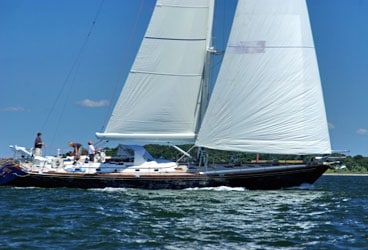
gmt furling boom 368
I’ve always liked the convenience of a roller-furling main, and I’ve always liked the power and balance that a full-battened main gives a boat. Unfortunately, the two often are mutually exclusive.
In-boom furling systems, in which the main is raised like a window shade going up, are changing that. I recently went for a sail aboard Sonny, a 70-foot Bristol that uses GMT’s new carbon-fiber furling boom. GMT takes in-boom furling a step further than the norm with a silent hydraulic furling motor that’s in the boom itself, eliminating the need for a mandrel through the mast and the complications of a universal joint at the gooseneck and mounting the furling motor in the mast.
A criticism of many in-boom furlers has been the need to have the boat pointing absolutely straight into the breeze so the sail furls properly or hoists without damage. This orientation isn’t necessary with the GMT boom. With the GMT, we successfully hoisted and furled the main with the wind on the beam; whether the sail was full or luffing made no difference in the 12-knot breeze. As with other in-boom furlers, the boom vang does have to be set to keep the boom at the correct angle; it takes practice to figure out, but it’s not rocket science.
Because of the cost of the new boom, GMT president David Schwartz thinks it unlikely that he’ll sell many of them to owners of boats much less than 50 feet, but he avers that his boom becomes a pretty good deal on bigger boats, when compared with similar systems. The in-boom furling setup on Sonny cost about $120,000.
GMT’s new carbon-fiber furling boom (www.gmtcomposites.com) is definitely a step forward in this technology, and I look forward to hearing from Sonny’s captain about how well the boom performed at sea.
Andrew Burton







